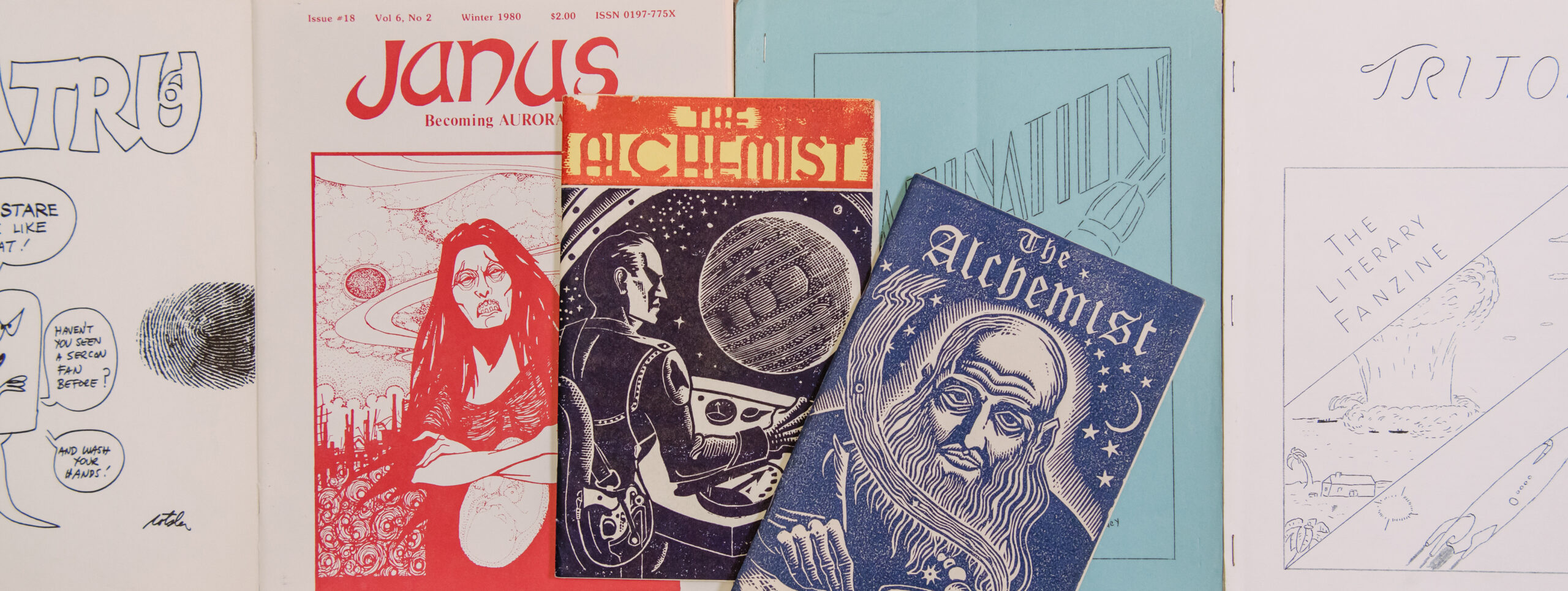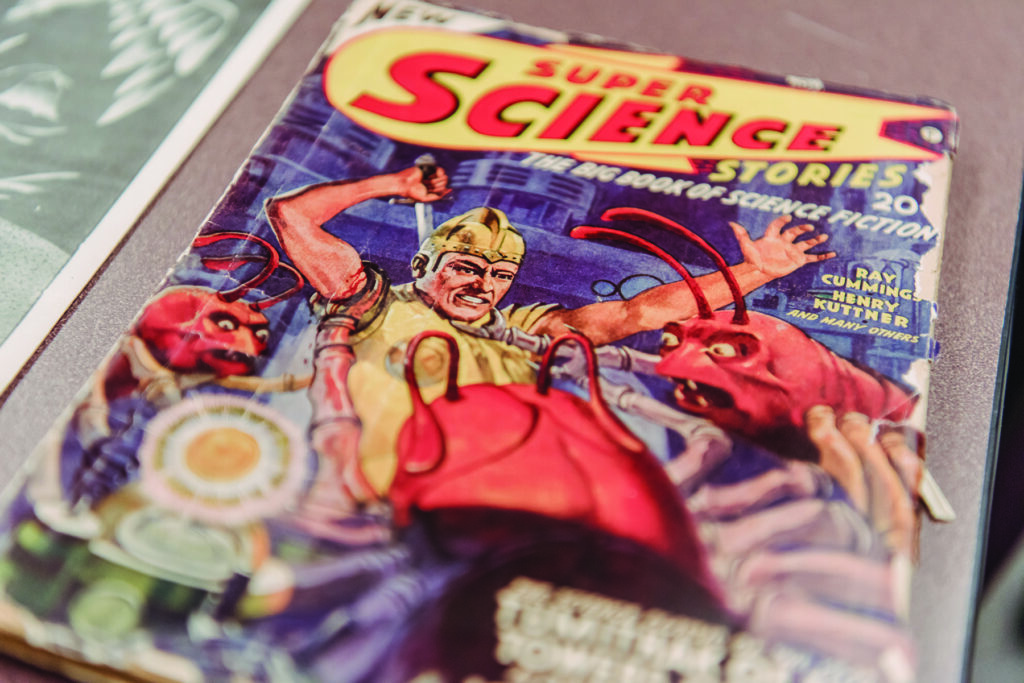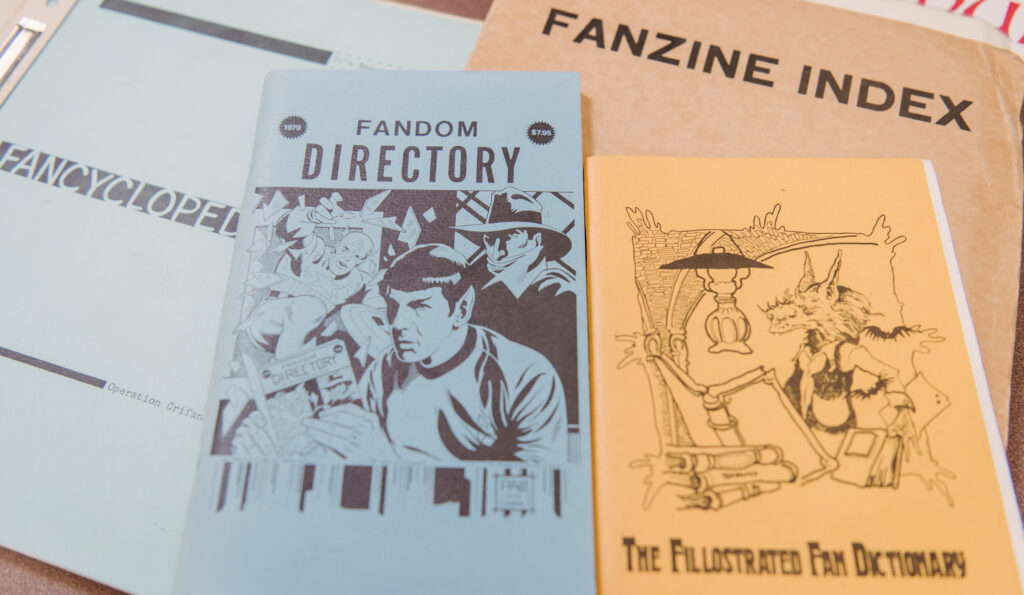With Susan Graham ’98, VPA & Anthropology, Special Collections Librarian at UMBC
Since the early 1900s, fans of science fiction and fantasy have produced thousands upon thousands of “fanzines” to showcase writing and art, discuss literature and politics of the era, and build community among fellow fans. Often produced by amateur editors, they have titles like Janus and Mirage and If!, and many are stapled together, copied by mimeograph, or even colored by hand. Many are filled with in jokes and turns of phrase meant to delight and engage a very specific — and passionate — readership.
These publications are unique, fun, and meant to be enjoyed. But, if you’ve never tried reading one, much less becoming an honest to goodness fanzine fan, where do you begin? Well, it just so happens that the Special Collections department of the Albin O. Kuhn Library houses the Coslet-Sapienza Fantasy and Science Fiction Fanzine Collection, which contains tens of thousands of amateur press science fiction and fantasy magazines produced from 1937 to 72. Among the collection you can find early works by famous authors like Ray Bradbury and Isaac Asimov, as well as undiscovered talents from across the genres.
Special Collections librarian Susan Graham ’98, is here to walk us through a few easy steps anyone can take to blast warp speed ahead into this exciting new (old, really) universe of literature. The key, of course, is knowing what to ask.
TOOLS OF THE TRADE
- A friendly librarian — like Susan!
- A section of great zines — like UMBC’s Coslet-Sapienza Fantasy and Science Fiction Collection.
- A bookish sense of adventure!
STEP 1: WHAT IS A FANZINE ANYWAY?
Fanzines are amateur publications that are created by fans of a particular genre of work for other fans of that genre. Work of this sort spans not only science fiction and fantasy, but also horror, mystery, crime, and other genres. The first American fanzine was called The Comet and published in May 1930, and the first use of the word “fanzine” was in the October 1940 issue of Detours, a hand-written mimeographed publication on hand in Special Collections.
So, what’s inside?
“They often had letters to the editor with fans discussing the works of other established writers…but they were also a venue for aspiring writers to write their own stories and artists who contributed artwork. There were poems, inside jokes,” as well as plans for get-togethers and conventions, Graham says. “Sometimes authors would even write in and have this sort of relationship with the fans” that kept them reading issue after issue.
STEP 2: HOW CAN I FIND FANZINES TO LOOK AT, AND WHAT KINDS ARE AVAILABLE?
Because their history is so deep and interesting, much is to be found online about fanzines and their background. Many titles from the Coslet-Sapienza collection are digitized and available via the UMBC Library website, where it’s easy to quickly learn about a range of titles and topics — from war to feminism — and even find out how to see them first-hand on campus.
Over the summer, a group of students new to fanzines spent several weeks exploring the collection through the CoLab program, digging deep into titles that interested them, and ultimately creating an online resource for people interested in the literature.
“They produced a great online exhibit that talks all about fanzines and how they were created,” says Graham. “If you’re just starting out, it’s a great place to begin.”
STEP 3: HOW CAN I LEARN MORE ABOUT THE FANZINE COMMUNITY?
Much like immersing oneself in the language of an undiscovered country, learning the ins and outs of fanzines can take some deep study. Much like travel, you can also easily lose yourself in the splendor of fanzine culture.
One great doorway in is through the library’s collections of Fantasy Amateur Press Association (FAPA) materials. A quick flip through some of their newsletters can give you a host of details about what readers enjoyed, and how they communicated with each other, Graham says.
Another is The Fillostrated Fan Dictionary by Elliot Weinstein, also on hand at the library, which offers definitions for hundreds of fandom-specific terms you didn’t even know you didn’t know. (Like “Bolega,” a “mythical fannish liquor,” or “Helicopter Beanie,” the “stereotyped head gear worn by all neo type fans,” to name just a couple.)
But, nothing quite compares to holding a fanzine in your hands and imagining who made it, says Graham.
“One thing that’s really special about fanzines is that some of them can look really homemade,” with original drawings and hand bindings that show the depth of commitment of the publisher, says Graham. “This was somebody’s passion, they loved it, they wanted to get work out there. They wanted to be a part of this community.”
The More You Know
Ready to get started? Here are some resources to get you on your way to fanzine fandom.
- Fanzine Lib Guide: Visit this guide online for history of fanzines, links to searches within the Coslet-Sapienza collection, digital copies of fanzines, and information on how to visit the collection in person. lib.guides.umbc.edu/fanzines
- CoLab Student Project: Dig in deeper to several specific titles in the Coslet-Sapienza collection through this in-depth student summer research project. umbcspecialcollections.omeka.net/exhibits/show/cosletsapienzafancoll
- Zine Wiki: Use this open-source encyclopedia devoted to zines and independent media to find out about a larger swath of zines, including history, production, distribution, and culture of the small press. Zinewiki.com
- Learn more about UMBC Special Collections and all of its wonderful holdings! library.umbc.edu/speccoll/
— Jenny O’Grady
Tags: AOK Library, Fall 2018, how to



